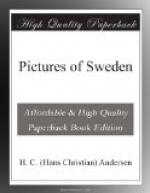I came, as I have said, here again in the autumn. I found the same rushing and roaring, the same din, the same rising and sinking in the sluices, the same chattering boys who conducted fresh travellers to the Hell Fall, to the iron-bridge island, and to the inn. I sat here, and turned over the leaves of books, collected here through a series of years, in which travellers have inscribed their names, feelings and thoughts at Trollhaetta—almost always the same astonishment, expressed in different languages, though generally in Latin: veni, vidi, obstupui.
One has written: “I have seen nature’s master-piece pervade that of art;” another cannot say what he saw, and what he saw he cannot say. A mine owner and manufacturer, full of the doctrine of utility, has written: “Seen with the greatest pleasure this useful work for us in Vaermeland, Trollhaetta.” The wife of a dean from Scania expresses herself thus. She has kept to the family, and only signed in the remembrance book, as to the effect of her feelings at Trollhaetta. “God grant my brother-in-law fortune, for he has understanding!” Some few have added witticisms to the others’ feelings; yet as a pearl on this heap of writing shines Tegner’s poem, written by himself in the book on the 28th of June, 1804:
“Gotha kom i dans fran Seves fjallar, &c.”
I looked up from the book and who should stand before me, just about to depart again, but the old man from Trollhaetta! Whilst I had wandered about, right up to the shores of Siljan, he had continually made voyages on the canal; seen the sluices and manufactories, studied steam in all its possible powers of service, and spoke about a projected railway in Sweden, between the Hjalmar and Venern. He had, however, never yet seen a railway, and I described to him these extended roads, which sometimes rise like ramparts, sometimes like towering bridges, and at times like halls of miles in length, cut through rocks. I also spoke of America and England.
“One takes breakfast in London, and the same day one drinks tea in Edinburgh.”
“That I can do!” said the man, and in as cool a tone as if no one but himself could do it, “I can also,” said I; “and I have done it.”
“And who are you, then?” he asked.
“A common traveller,” I replied; “a traveller who pays for his conveyance. And who are you?”
The man sighed.
“You do not know me: my time is past; my power is nothing! Bloodless is stronger than I!” and he was gone.
I then understood who he was. Well, in what humour must a poor mountain sprite be, who only comes up every hundred years to see how things go forward here on the earth!
It was the mountain sprite and no other, for in our time every intelligent person is considerably wiser; and I looked with a sort of proud feeling on the present generation, on the gushing, rushing, whirling wheel, the heavy blows of the hammer, the shears that cut so softly through the metal plates, the thick iron bars that were broken like sticks of sealing-wax, and the music to which the heart’s pulsations vibrate: “Banco, Banco, a hundred thousand Banco!” and all by steam—by mind and spirit.




